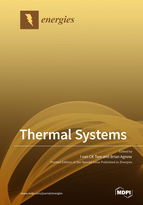Thermal Systems
A special issue of Energies (ISSN 1996-1073). This special issue belongs to the section "J: Thermal Management".
Deadline for manuscript submissions: closed (30 June 2020) | Viewed by 31253
Special Issue Editors
Interests: thermal power systems; refrigeration; combined cycles; internal combustion engines; finite time thermodynamics
Special Issues, Collections and Topics in MDPI journals
Interests: engine combustion process; exhaust emission control; energy management; renewable energy; cryogenic technology
Special Issues, Collections and Topics in MDPI journals
Special Issue Information
Dear Colleagues,
We live in interesting times in which life as we know it is being threatened by manmade changes to the atmosphere in which we live. On the global scale, concern is focused on climate change due to greenhouse gas emissions, and on a national scale, atmospheric pollution produced by combustion processes is of concern. To meet the dual challenges presented by these factors, consideration needs to be given to energy efficiency and pollution reduction in transport and energy conversion processes. A possible approach is through the development of new ideas, processes, and practices.
In this Special Issue on " Thermal Systems”, we welcome review articles and original research papers, fundamental or applied and theoretical, numerical, or experimental, which explore new concepts in thermal systems and energy utilization. Topics of interest include, but are not limited to, the following:
- Combined cycles (CHP and cooling);
- Organic Rankine cycles;
- Component performance;
- Combustion processes;
- Solar power;
- Geothermal energy;
- Bio-fuels;
- Heat transfer;
- Finite time thermodynamics;
- Exergy and Second Law analysis;
- Energy efficiency;
- Nano-fluids.
Dr. Ivan CK Tam
Guest Editors
Manuscript Submission Information
Manuscripts should be submitted online at www.mdpi.com by registering and logging in to this website. Once you are registered, click here to go to the submission form. Manuscripts can be submitted until the deadline. All submissions that pass pre-check are peer-reviewed. Accepted papers will be published continuously in the journal (as soon as accepted) and will be listed together on the special issue website. Research articles, review articles as well as short communications are invited. For planned papers, a title and short abstract (about 100 words) can be sent to the Editorial Office for announcement on this website.
Submitted manuscripts should not have been published previously, nor be under consideration for publication elsewhere (except conference proceedings papers). All manuscripts are thoroughly refereed through a single-blind peer-review process. A guide for authors and other relevant information for submission of manuscripts is available on the Instructions for Authors page. Energies is an international peer-reviewed open access semimonthly journal published by MDPI.
Please visit the Instructions for Authors page before submitting a manuscript. The Article Processing Charge (APC) for publication in this open access journal is 2600 CHF (Swiss Francs). Submitted papers should be well formatted and use good English. Authors may use MDPI's English editing service prior to publication or during author revisions.
Keywords
- combined cycles (CHP and cooling)
- organic rankine cycles
- component performance
- combustion processes
- solar power
- geothermal energy
- bio-fuels
- heat transfer
- finite time thermodynamics
- exergy and second law analysis
- energy efficiency
- nano-fluids.







